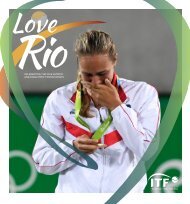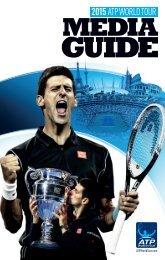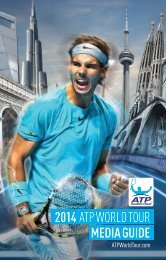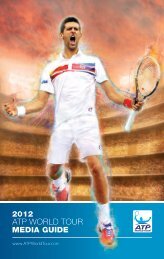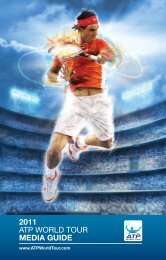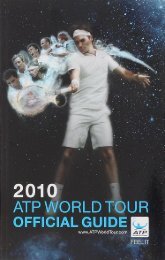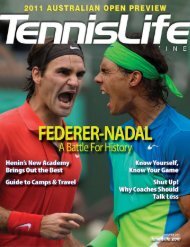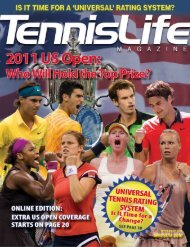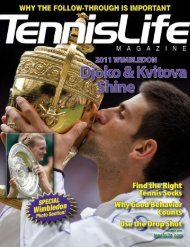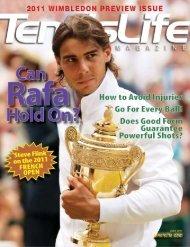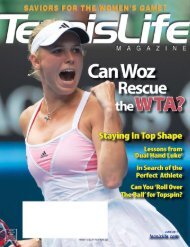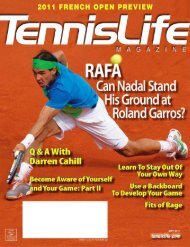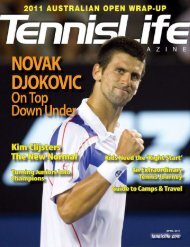A Champion's Mind - Pete Sampras
www.tennismoscow.me Insta:TENNISMOSCOW
www.tennismoscow.me Insta:TENNISMOSCOW
You also want an ePaper? Increase the reach of your titles
YUMPU automatically turns print PDFs into web optimized ePapers that Google loves.
during practice or in matches. It was just a dull, throbbing pain, very uncomfortable, like a toothache in<br />
my arm. And when it was bad, it affected my service speed and, of course, my enthusiasm and confidence.<br />
I began to take Advil, in combination with the Indocin, a very powerful anti-inflammatory. I took them<br />
religiously after practice and matches. Pretty soon I was popping the Indocin and Advil cocktails before<br />
matches as a preventative measure. But as I got hooked on the Indocin, I suddenly found myself unable to<br />
keep food down. Before my 1994 Wimbledon semifinal with Todd Martin, I drank some water and<br />
promptly threw it back up. On the morning of the 1994 Grand Slam Cup final, I woke up feeling sick. I<br />
had the dry heaves but tried to force down breakfast anyway, and it came back up. I felt awful.<br />
I was really settling into my number one position by then, however, and I didn’t want to take time off; I<br />
wanted to give it the gas, so I just pushed on. Not long after that Key Biscayne match, I went to see my<br />
doctor in Tampa, and he ran tests on my upper gastrointestinal tract. It established beyond dispute that I<br />
had an ulcer, and the physician thought it was from a combination of stress and the Indocin. He said if I<br />
was lucky, and took the right medication, I could be rid of the ulcer in three months. So on top of Vitas’s<br />
tragic death and Tim’s sudden illness, now I had a three-pill-a-day regimen to follow.<br />
By February of 1995, it was pretty clear that this was not going to be a routine year. I had a lot on my<br />
plate, including Davis Cup. I’d told the USTA that I would be available for the entire campaign, which<br />
could be as many as four ties.<br />
Some years the Davis Cup challenge appealed to me, and some years it didn’t. It never had anything to<br />
do with money. In fact, the money was lousy by any standard. We would typically get something like<br />
fifteen or twenty thousand dollars to play, and if our home ties earned money, we got a little additional<br />
revenue in a profit-sharing system. But trust me, it was minimal. Given that a Davis Cup tie is actually a<br />
full week’s commitment (sometimes more, if you got there a day or two early), the pay was shockingly<br />
low for guys who could pull down four or five times as much for a one-night exhibition.<br />
I understood the unique nature of Davis Cup. I had reasons other than money for running hot and cold on<br />
the competition. To win the Davis Cup requires a four-week commitment, which is the equivalent of two<br />
Grand Slams. You also aren’t sure in advance who you’re going to play round by round, or where the ties<br />
will be held. Fans often are confused by Davis Cup’s unwieldy format and traditions. A number of times,<br />
I’d be part of a winning team only to have to explain to well-wishers or even reporters that we didn’t<br />
actually win the Davis Cup that day—we’d merely won the tie to advance to the next one, months away. I<br />
understand that all that stuff is part of what makes Davis Cup compelling, but I just never fully bought into<br />
it.<br />
My attitude might have been different if we had developed a Davis Cup team spirit comparable to that<br />
of the present U.S. squad, with Andy Roddick and James Blake leading. They have great team spirit and<br />
camaraderie, but then they aren’t competing against each other for Grand Slam titles. My generation<br />
consisted of four Grand Slam champions (Andre, Jim, Michael Chang, and me) who were perennial topfive<br />
contenders, and a handful of lesser but still terrific players. We were rivals and competitors, and<br />
even though we all got along pretty well, we were always circling each other, sniffing, gauging our next<br />
moves. That doesn’t lend itself to creating great team spirit, because most teams rely on a dominant leader<br />
(like Roddick), and none of us was inclined to play second fiddle to anyone else.<br />
The comparison between Davis Cup, which struggles to get adequate exposure and public respect, and<br />
golf’s hugely successful Ryder Cup is interesting: Ryder Cup is a one-week event played every two years.<br />
Davis Cup is an annual event, played in four rounds on a rolling basis in unpredictable places. I wish they<br />
would adopt a different Davis Cup model—play it in one place, over a specific period (two weeks would<br />
be ideal), and see what happens.<br />
Davis Cup did grow on me (I ended up playing sixteen ties and helped win the Cup twice—that’s a lot



